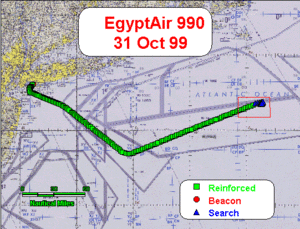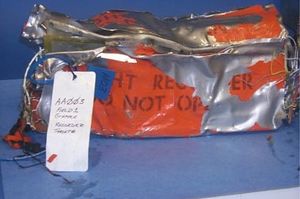Difference between revisions of "EgyptAir Flight 990"
(image fix) |
|||
| Line 11: | Line 11: | ||
The [[Egyptian Civil Aviation Authority]] (ECAA) lacked the resources of the US [[National Transportation Safety Board]] (NTSB), so the Egyptian government requested the NTSB to handle the investigation. Two weeks after the crash, the NTSB proposed handing the investigation over to the [[Federal Bureau of Investigation]], as the evidence suggested that a criminal act had taken place and that the crash was intentional rather than accidental. | The [[Egyptian Civil Aviation Authority]] (ECAA) lacked the resources of the US [[National Transportation Safety Board]] (NTSB), so the Egyptian government requested the NTSB to handle the investigation. Two weeks after the crash, the NTSB proposed handing the investigation over to the [[Federal Bureau of Investigation]], as the evidence suggested that a criminal act had taken place and that the crash was intentional rather than accidental. | ||
| + | [[image:EgyptAir Flight 990 data recorder.jpg|left|300px|thumbnail|The damaged flight data recorder]] | ||
The official probable cause of the crash was found to be a deliberate act by the relief first officer.<ref name=ntsb>{{cite web|title=Aircraft Accident Brief: EgyptAir Flight 990 |url=http://www.ntsb.gov/doclib/reports/2002/AAB0201.pdf |publisher=[[NTSB]] |date=March 2002 |archiveurl=http://www.webcitation.org/5zlFg31jj?url=http://www.ntsb.gov/doclib/reports/2002/AAB0201.pdf |archivedate=27 June 2011 |deadurl=yes |df=dmy }}</ref><ref>{{cite news |first=Shreeya |last=Sinha |title=A History of Crashes Caused by Pilots' Intentional Acts |url=https://www.nytimes.com/interactive/2015/03/26/world/history-plane-crashes-pilots.html |quote=Investigators concluded that the most likely explanation was that the co-pilot, Gameel al-Batouti, deliberately brought down the plane, although they sidestepped the question of motive and Egyptian officials have disputed that conclusion. |newspaper=[[The New York Times]] |date=26 March 2015 |accessdate=18 April 2015}}</ref> | The official probable cause of the crash was found to be a deliberate act by the relief first officer.<ref name=ntsb>{{cite web|title=Aircraft Accident Brief: EgyptAir Flight 990 |url=http://www.ntsb.gov/doclib/reports/2002/AAB0201.pdf |publisher=[[NTSB]] |date=March 2002 |archiveurl=http://www.webcitation.org/5zlFg31jj?url=http://www.ntsb.gov/doclib/reports/2002/AAB0201.pdf |archivedate=27 June 2011 |deadurl=yes |df=dmy }}</ref><ref>{{cite news |first=Shreeya |last=Sinha |title=A History of Crashes Caused by Pilots' Intentional Acts |url=https://www.nytimes.com/interactive/2015/03/26/world/history-plane-crashes-pilots.html |quote=Investigators concluded that the most likely explanation was that the co-pilot, Gameel al-Batouti, deliberately brought down the plane, although they sidestepped the question of motive and Egyptian officials have disputed that conclusion. |newspaper=[[The New York Times]] |date=26 March 2015 |accessdate=18 April 2015}}</ref> | ||
Revision as of 11:12, 28 April 2017
 | |
| Location | Atlantic Ocean, 100 km (62 mi) S of Nantucket |
|---|---|
EgyptAir Flight 990 (MS990/MSR990) was a regularly scheduled flight from Los Angeles International Airport, United States, to Cairo International Airport, Egypt, with a stop at John F. Kennedy International Airport, New York City. On 31 October 1999, the Boeing 767 operating the route crashed into the Atlantic Ocean about 60 miles south of Nantucket Island, Massachusetts, killing all 217 people on board. The NTSB concluded this was a deliberate act, the ECAA disputed this conclusion.
Official investigations
The Egyptian Civil Aviation Authority (ECAA) lacked the resources of the US National Transportation Safety Board (NTSB), so the Egyptian government requested the NTSB to handle the investigation. Two weeks after the crash, the NTSB proposed handing the investigation over to the Federal Bureau of Investigation, as the evidence suggested that a criminal act had taken place and that the crash was intentional rather than accidental.
The official probable cause of the crash was found to be a deliberate act by the relief first officer.[1][2]
The ECAA then reversed its decision and launched its own investigation, which concluded that the accident was caused by mechanical failure of the aircraft's elevator control system.
Other circumstances
The flight had an unprecedented 33 members of the Egyptian General Staff, contrary to standard operating procedure.[citation needed] There were those who opined that it was an action (and potentially a conspiracy) of Muslims or that the Mossad had targeted them.[3]
References
- ↑ "Aircraft Accident Brief: EgyptAir Flight 990" (PDF). NTSB. March 2002. Archived from the original (PDF) on 27 June 2011. Cite uses deprecated parameter
|deadurl=(help)Page Module:Citation/CS1/styles.css must have content model "Sanitized CSS" for TemplateStyles (current model is "Scribunto"). - ↑
{{URL|example.com|optional display text}} - ↑ Piotrowski, William K. (Spring 2000). Religion in the News. Trinity College Pugh Trust accessdate=January 15, 2011. 3 (1 title=What’s in a Name?: The Crash of EgyptAir 990) http://www.trincoll.edu/depts/csrpl/rinvol3no1/egyptair.htm. Missing pipe in:
|number=(help); Missing pipe in:|publisher=(help); Missing or empty|title=(help)Page Module:Citation/CS1/styles.css must have content model "Sanitized CSS" for TemplateStyles (current model is "Scribunto").
